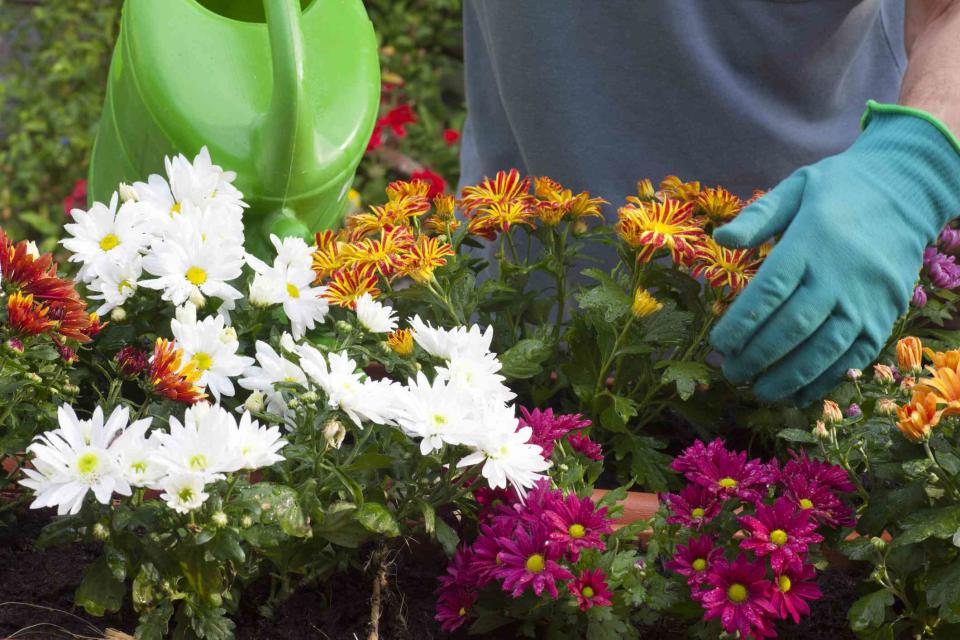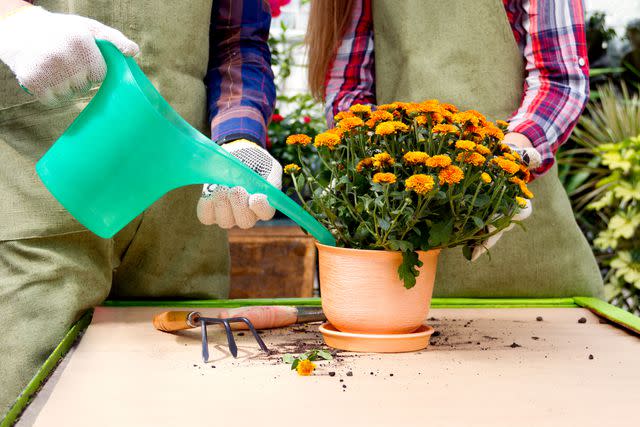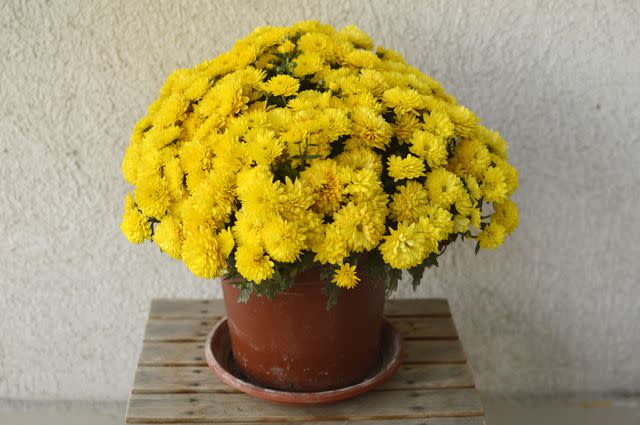How Often You Should Water Your Mums to Ensure Happy Blooms
Follow these essential care tips for watering mums

ArtmannWitte / Getty Images
You should water your mums (in pots or the ground) whenever the soil feels dry, but this is especially true for potted mums, which could need water daily in warm, sunny fall weather.
Mums grow best in moist soil and struggle when their roots dry out, so you need to water as much and as often as necessary to prevent this from happening. Because annual florist mums are mostly grown in pots and hardy garden mums in garden soil, they have different watering needs.
Follow these tips for watering both florist mums and hardy garden mums.
Fast Facts
Water slowly and deeply when the top 1 to 2 inches of soil feel dry.
Grow mums in loose, well-drained soil and keep it moist but not wet.
Water at the base of the plant or bottom-water potted plants. Do not water from above and try not to get the foliage wet.
How Often to Water Potted Florist Mums
Florist mums, which are usually grown in pots, have higher watering needs than mums that are planted in garden beds. Like all potted plants, they dry out much faster than plants in the ground. In warm fall weather, they will likely need daily watering.
When you buy your florist mums in the late summer or early fall, the days are often still warm or even hot, so you should check the soil moisture daily and water as needed. The drier the soil, the slower you should water, otherwise the water will just run off. You can also lift the pot—if it feels lightweight, it’s time to water.
Tip
If you are unsure whether the plant needs water, insert a finger a couple of inches into the soil surface; if it feels dry, give the plant a drink.
It is not unusual for florist mums to be rootbound in their containers when you buy them. Gently lift the plant out of its container to check if that is the case and repot it in a larger container with fresh potting soil. In an overcrowded pot, the roots cannot properly take up water. Make sure that the container has large drainage holes because mums do not like to sit in soggy soil.
Slowly water the soil until the water starts to run out of the drainage holes. Alternatively, you can place the pot in a deep saucer and fill it with water. Let it sit for 30 minutes and pour out the water that has not been absorbed.
Wait with the next watering until the soil feels dry or light again. Mums do best if the soil dries out between waterings.

monstArrr_ / Getty Images
How Often to Water Garden Mums
Unlike florist mums, garden mums are mostly planted in the landscape where the garden soil holds moisture much better than potting soil. It still helps to lightly mulch around the plants to help preserve soil moisture.
After you have planted your hardy mums, water them well. Just as with florist mums, always water slowly and deeply. Keep the soil evenly moist for the first few weeks after planting so that the mum can develop a good root system. If there is not sufficient rain, water regularly and never let the soil dry out. Just like with potted plants, do the finger test to check.
By mid-summer, the fast-growing hardy mums are usually well established, but you should continue to keep a close eye on the soil moisture level and water if there is less than 1 inch of rain per week. The plant may survive a dry spell, but lack of water can lead to poor or no bloom in the fall.

Jana Milin / Getty Images
Frequently Asked Questions
Should you soak mums in a bucket?
Soaking the plant in a bucket of water is usually the last resort in very hot weather or when the plant has been neglected and the soil has dried out severely. Place the mum with its pot in a bucket with a few inches of water. Let it sit for an hour or so until the soil has been rehydrated, which you can tell from the heavy weight of the pot when you lift it. Remove the pot from the bucket promptly.
Should you water mums in the morning or in the evening?
Either the early morning or late evening is fine. Water your mums when the temperatures are the coolest and there is little or no sun, which prevents fast evaporation.
What happens if I overwater mums?
Overwatering mums can be just as bad as underwatering them. Soil with poor drainage or growing mums in pots with inadequate drainage holes causes problems. In wet, saturated soil, the leaves become mushy, and the roots can rot. Overwatering can also cause the leaves to turn yellow (and then black before they drop). Gardeners sometimes misinterpret this as a lack of water and water even more. Always let the soil surface dry out before watering again.
Read Next: How to Avoid Killing Your Mums
Read the original article on The Spruce.

